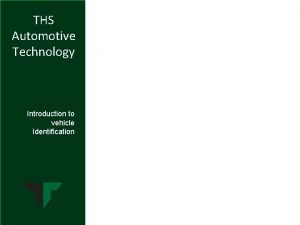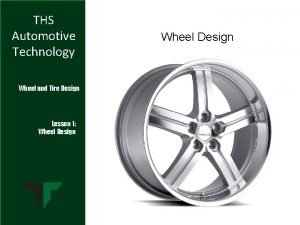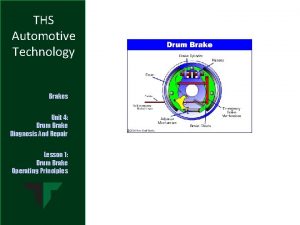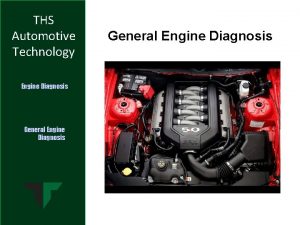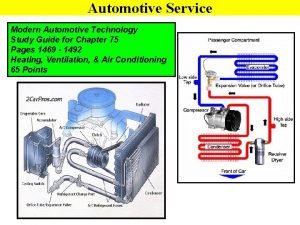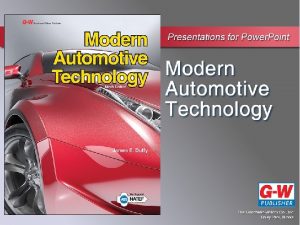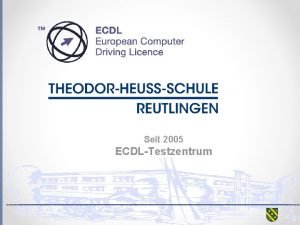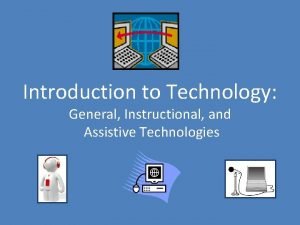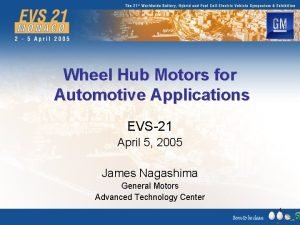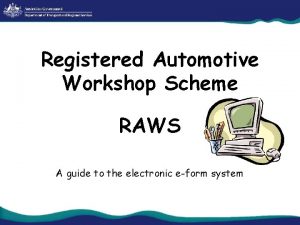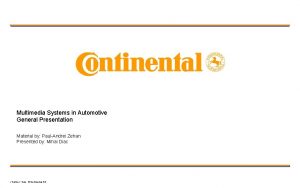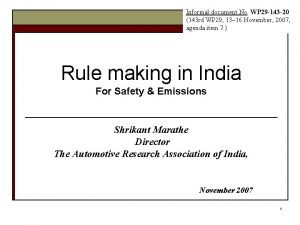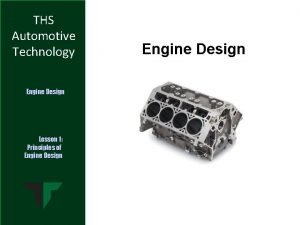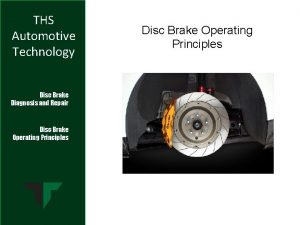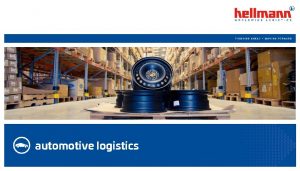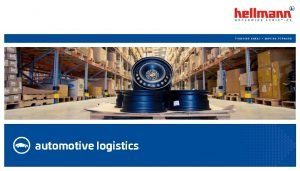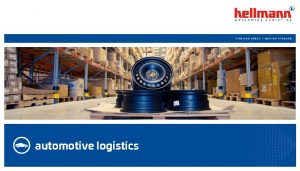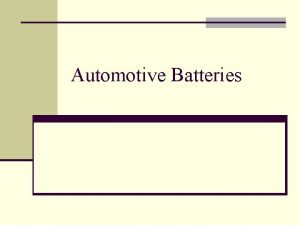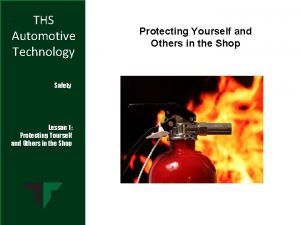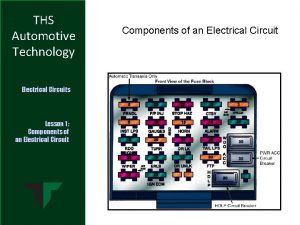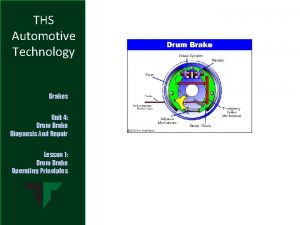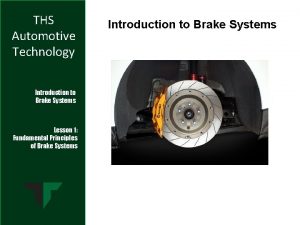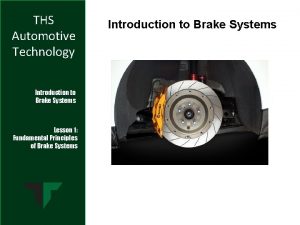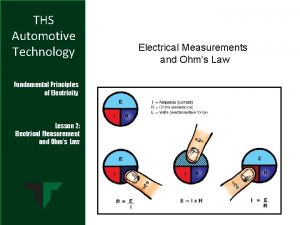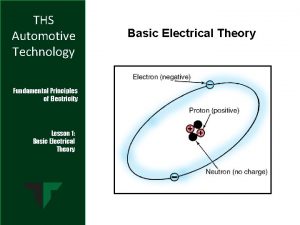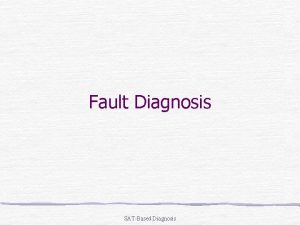THS Automotive Technology Engine Diagnosis General Engine Diagnosis




































- Slides: 36

THS Automotive Technology Engine Diagnosis General Engine Diagnosis

THS Automotive Technology The automotive technician needs to be familiar with the functions and components of a work order. NOTE: See JS 1 -L 1 -U 2 for a sample work order. Engine Diagnosis • The work order serves several functions. Itemizes the repairs by listing the cost of parts and labor Can be used to authorize the repair General Engine Diagnosis Has the necessary information on how to contact the owner and serves as documentation for future reference May also specify limited warranties and liabilities of the shop May serve as a reference for recent service history for warranty or legal purposes

THS Automotive Technology The automotive technician needs to be familiar with the functions and components of a work order. • A work order typically has the following components. Engine Diagnosis Customer name, address, and phone number (home or work with extension number) Date General Engine Diagnosis Invoice number Year, make, model, vehicle identification number (VIN), and mileage of the vehicle Name/initials of the service writer and technician Customer authorization signature to allow repairs Description of customer concern Vehicle service history information

THS Automotive Technology The automotive technician needs to be familiar with the functions and components of a work order. Related technical service bulletins (TSB) Engine Diagnosis Technician's notes that includes diagnostic procedures performed, the results of diagnosis, and any important observations or remarks Component or system defect responsible for the concern General Engine Diagnosis Service performed to successfully correct the concern Labor procedures and costs based on the parts and labor estimation guides Outside labor procedures and costs that include if a shop sent a particular part out to another shop for repairs Listing of each part that includes name, description, and cost

THS Automotive Technology The automotive technician needs to be familiar with the functions and components of a work order. Sales tax, which is usually calculated on parts only Engine Diagnosis General Engine Diagnosis Total that represents the final price that the customer will pay for all charges related to the repair

THS Automotive Technology The automotive technician needs to be familiar with the functions and components of a work order. • Work orders may be handwritten or prepared by entering codes in a computer terminal and then printed. Engine Diagnosis General Engine Diagnosis • Depending on the part, the following information may be required for ordering repair parts. Make, model, and model year (found on the driver’s side door jamb) of the vehicle VIN Engine information that includes engine size, in cubic inches or liters, the number of cylinders, and the type of fuel system Wheelbase Number of doors

THS Automotive Technology Procedure for identifying and interpreting engine concerns • Ask the owner/driver to describe the engine concerns. When did the concern first occur? Engine Diagnosis Is the malfunction indicator light (MIL) on or flashing? Is the concern continuous or intermittent? What are the driving conditions when the concern occurs? General Engine Diagnosis Is the vehicle making any unusual noises or vibrations? What is the recent service history of the vehicle?

THS Automotive Technology Engine Diagnosis General Engine Diagnosis Procedure for identifying and interpreting engine concerns • Perform a road test to verify the information provided by the owner/driver. CAUTION: Road test a vehicle only with the instructor’s approval. Before performing a road test, inspect the vehicle to ensure that the vehicle is safe and that a road test will not cause damage to the vehicle. The road test should be performed by the individual who will perform the repairs. Ask the owner/driver to ride along during the road test. The owner/driver can assist in identifying the source of any problems. Drive the vehicle at all speeds and engine power levels that could have a bearing on the owner/driver’s concern.

THS Automotive Technology Procedure for identifying and interpreting engine concerns Record all abnormal conditions. • Engine performance conditions Engine Diagnosis • Engine noises or vibrations • Exhaust smoke General Engine Diagnosis CAUTION: Safety should be of prime importance during all road tests. Never drive in an unsafe manner in order to identify a problem. • Record the vehicle’s identification numbers (VIN, certification labels, and calibration information).

THS Automotive Technology Engine Diagnosis Procedure for identifying and interpreting engine concerns • Research service information related to the owner/driver’s concern. Technical service bulletins (TSB) Vehicle service information and service precautions • Connect a scan tool and check for stored diagnostic trouble codes (DTCs). General Engine Diagnosis • Based on the information gathered, determine what diagnostic procedures should be performed to locate the concern.

THS Automotive Technology Engine Diagnosis Procedures for performing a preliminary engine inspection CAUTION: The steps in this procedure that require the engine to be running must be performed outdoors because they must be done without exhaust ventilation equipment connected to the tailpipe. • Perform a visual engine inspection. Make sure to record all observations. Inspect the spark plug wires for wear and damage. General Engine Diagnosis Inspect the primary wiring for wear and damage. Look for wiring that is bare, burned, or disconnected. Inspect the battery terminals for damage and debris. Inspect the air filter for dirt and damage. Inspect the drive belts for wear and damage. Check the oil level and condition. Inspect for oil leaks.

THS Automotive Technology Engine Diagnosis Procedures for performing a preliminary engine inspection Check the coolant level and condition. Inspect for coolant leaks. Inspect for fuel leaks. Inspect for any other leaks. General Engine Diagnosis • If the vehicle uses excessive oil, perform the following steps to check for external oil leaks and record all observations. Check external surfaces and parts for leaks. Check for worn or damaged seals and gaskets. NOTE: It may be necessary to power wash the engine to make it easier to detect the source of a leak.

THS Automotive Technology Engine Diagnosis Procedures for performing a preliminary engine inspection Raise the vehicle and check under the engine for signs of leakage. CAUTION: When lifting a vehicle, always use proper lifting equipment and observe all safety precautions. NOTE: A fluorescent dye can be added to the engine oil to help in detecting the source of a leak. The dye makes the oil glow a different color under an ultraviolet light. General Engine Diagnosis • If the source of an external leak cannot be found, perform the following steps to check for internal oil leaks. Start the engine and allow it to reach normal operating temperature. Observe the color of the smoke coming out of the exhaust system. A blue color indicates oil in the combustion chamber. Record observations.

THS Automotive Technology Engine Diagnosis Procedures for performing a preliminary engine inspection • While the engine is running, listen for abnormal engine noises or vibrations. Make sure to record all observations. Shut off the engine and allow it to cool completely. • Start the engine. Perform a visual inspection of the exhaust system. Make sure to record all observations. Shut off the engine. General Engine Diagnosis With the engine started cold, check the exhaust color, sound, and odor. With the engine at idle, check the exhaust color, sound, and odor. With the engine at 2, 000 rpm, check the exhaust color, sound, and odor. • Determine the necessary action to correct any problems. Include further diagnosis and/or repairs.

THS Automotive Technology Engine Diagnosis Evaluating engine noise • Locating and evaluating engine noise is a very difficult diagnostic job. A technician’s stethoscope, or probe, is helpful in successfully evaluating engine noise. The stethoscope can be moved around until the exact location of the noise is determined. • Important engine sounds Defective rod bearings produce a knocking sound. General Engine Diagnosis • The rod bearing knock sounds loudest at the lower part of the engine. • The rod bearing knock also sounds loudest at a particular engine speed. During the road test, the rod bearing knock will be speed sensitive, becoming quieter as speed is increased or decreased. When rod bearing noise becomes more severe, it will tend to lose this speed sensitivity.

THS Automotive Technology Engine Diagnosis Evaluating engine noise A knock at the piston (wrist) pin sounds somewhat like a rod bearing knock but will be much higher in the engine than the rod knock. • In some cases, the location of the knock may be the only way to determine if it is coming from a rod or from a piston pin. • In other cases, the rod bearing and piston pin produce two different types of noise. General Engine Diagnosis NOTE: Distinguishing between a wrist pin knock and a rod bearing knock is not crucial. Repairing either component requires disassembly and measurement of the engine. A piston slap sounds much like a wrist pin knock. However, unlike a wrist pin knock, a piston slap quiets down as the engine warms up. Correction of the piston slap also requires engine disassembly and measurement.

THS Automotive Technology Engine Diagnosis General Engine Diagnosis Evaluating engine noise A main bearing knock sounds more like a dull thud than a knock. A main bearing knock comes from lower in the engine. The knock is loudest when the engine is under a moderate to heavy load. Some engines use timing chains. A twangy sound coming from the front of the engine is usually the result of a noisy timing chain. Valves sometimes produce a clicking sound that comes from high in the engine. The valve clicking sound has a higher frequency than a bearing knock. • Generally, if internal noises are heard in the lower part of the engine, disassembly of the engine is required. Noises coming from near the head may be caused by combustion chamber deposits that have come loose and are contacting the tops of the pistons at each stroke. This may require removal of the cylinder heads.

THS Automotive Technology Engine Diagnosis Diagnosing excessive oil consumption • Most vehicle manufacturers consider oil consumption of less than 1 qt every 1, 000 miles to be normal. Oil consumption can be reduced below this level, but the cost of doing so is very high. The gain in engine performance may not be worth the expense. • Oil consumption almost always occurs as a result of oil leaking out of its normal location. General Engine Diagnosis Oil may leak out of the engine through a seal or gasket onto the ground. Even a relatively small oil leak can cause the loss of 1 qt of oil over 1, 000 miles of vehicle operation. Oil may leak into the combustion chamber or into the induction system where the oil will be burned with the normal air/fuel mixture. Excessive engine blowby or a fuel leak into the oil pan can dilute the oil.

THS Automotive Technology Engine Diagnosis Diagnosing excessive oil consumption • Locating and eliminating the route by which the oil is leaving the engine stops excessive oil consumption. Oil can be leaving the engine by several routes in an older vehicle. • Oil leakage is classified as either external or internal. External leakage can be detected visually. General Engine Diagnosis • Usually external oil leaks at the engine gaskets are the easiest to find. The problem can usually be detected during a visual inspection of the gaskets. Some vehicles require that the engine be removed before the gaskets can be replaced. Check for the proper procedure in the service information. • The leakage can be so slight that the source is not apparent or so massive that the source of the leak is covered with oil.

THS Automotive Technology Engine Diagnosis Diagnosing excessive oil consumption • In some cases, the engine must be washed off and run in short cycles to prevent large leaks from flooding the leak area. At other times, the leak area can be washed and coated with a tracing powder to pinpoint an oil seep. An aerosol foot powder is often used for this purpose. Internal leakage is very difficult to detect. In fact, internal leakage will often continue without being detected. General Engine Diagnosis • Oil can leak into the induction system at many locations in the engine. One must be sure to find all leaks and recommend procedures for repairing the leaks. If any leaks are missed, the job will not be completely successful. • Oil can enter the intake manifold at any point where oil is close to a leaking intake manifold gasket. Intake manifold vacuum will suck the oil into the manifold and deliver it to the cylinder with the air/fuel mixture.

THS Automotive Technology Engine Diagnosis General Engine Diagnosis Diagnosing excessive oil consumption • Oil can enter the intake runner through defective valve guides. The intake stroke applies its vacuum directly to the intake valve stem. If the valve stems or valve guides are worn, or if the valve stem seals are defective, oil can be drawn into the intake runner at the cylinder intake port. This oil would then be delivered to the cylinder and burned.

THS Automotive Technology Engine Diagnosis General Engine Diagnosis Diagnosing excessive oil consumption One sign of this condition is a heavy blue smoke coming from the tailpipe immediately after the vehicle is started. The volume of smoke will slowly be reduced as the engine warms. Diagnosis of oil entering the intake runner through defective valve guides can be complicated by a low compression reading on the affected cylinders. The low reading is caused by the oil coking on the backs of the intake valves. A cylinder leakage test will show that compression is at the proper level. The intake valve seals can be replaced without removing the cylinder head. Care should be taken in making this decision because only the seals can be replaced; there may be guide wear present that cannot be repaired without disassembling the cylinder head. The recommended procedure here is to recondition the cylinder head.

THS Automotive Technology Engine Diagnosis General Engine Diagnosis Diagnosing excessive oil consumption • Oil can enter the induction system as a result of a vacuum. At a point between the exhaust stroke and the intake stroke, the exhaust valve will still be open though the piston has reached the top of its stroke. At this point, the weight of the exhaust gases moving out of the engine can cause a vacuum in the combustion chamber. This vacuum is momentary but can be strong enough to pull oil through the exhaust valve guide. Once pulled through the exhaust valve, the oil will be burned by the hot exhaust gases in the exhaust manifold. Cylinder head reconditioning can remedy the oil consumption problems created by this vacuum.

THS Automotive Technology Engine Diagnosis General Engine Diagnosis Diagnosing excessive oil consumption • Oil can enter the combustion chamber through pistons and piston rings. Worn or broken piston rings can allow oil to be drawn past them into the combustion chamber when it is in a vacuum. When combustion occurs, gases are blown past the rings into the crankcase, thus pressurizing the crankcase. This pressurization increases any oil leakage in the engine. Pistons that are cracked, “holed, ” scuffed, or otherwise damaged can result in oil consumption and/or ring damage.

THS Automotive Technology Engine Diagnosis General Engine Diagnosis Diagnosing excessive oil consumption Defective pistons or piston rings can cause low compression readings in the affected cylinders. A subsequent cylinder leakage test will also indicate leakage and the air will be heard escaping at the oil fill hole. These problems can be remedied by reconditioning the short block. • High-mileage engines that consume excessive amounts of oil often have multiple problems. A diagnosis of such vehicles will reveal that the entire engine assembly is worn. If any part of the assembly is repaired in order to reduce an oil consumption problem, the repair could place additional strain on another part of the engine. Therefore, high-mileage engines are best completely reconditioned the first time; any partial reconditioning may actually increase oil consumption.

THS Automotive Technology Engine Diagnosis Procedure for inspecting, removing, and installing engine covers • Remove the engine components that are blocking access to the engine cover. • Unfasten the cover and lift it off. If the cover does not come off easily, tap it with a rubber hammer to loosen it. • Inspect the cover for damage and warpage. • Remove the old gasket, seal, or sealer. General Engine Diagnosis • Clean the cover thoroughly with a parts washer or soap and water. Be sure to remove all debris and gasket residue. • Use a gasket scraper to remove debris and gasket residue from the mating surface. • Install the new gasket, seal, or sealer as specified in the service information.

THS Automotive Technology Engine Diagnosis Procedure for inspecting, removing, and installing engine covers • Install the cover and refasten it per specifications. • Install the engine components that were removed to access the engine cover. • Connect the exhaust ventilation equipment. General Engine Diagnosis CAUTION: Be sure to use approved exhaust ventilation equipment when operating a vehicle in an enclosed area. • Start the engine to ensure that the cover does not leak. • Shut off the engine and disconnect the exhaust ventilation equipment.

THS Automotive Technology Diagnosing oil pressure problems • No oil pressure Much of the time, severe engine damage results before a complete lack of oil pressure is detected. Engine Diagnosis When engine problems such as crankshaft damage are discovered, make sure that the damage is not caused by a defective oil system. If engine components are repaired, but the oil system problems go uncorrected, the same damage is likely to occur again. General Engine Diagnosis The oil pressure can fall to zero when the oil level in the engine drops below the level of the pickup screen. • This drop in the oil level may be the result of an oil leak or simply the failure to change or add oil to the vehicle. • Another possible reason for a drop in oil level is oil filter damage caused by a foreign object.

THS Automotive Technology Engine Diagnosis Diagnosing oil pressure problems • Low oil pressure is usually caused by one of the following problems: • A plugged pickup screen or tube • An internal oil leak in the pickup tube above the oil level in the engine General Engine Diagnosis • A leak in the oil gallery in the block or head • Oil that has been diluted with fuel First, check the oil level and the condition of the oil. If the oil level is low or if the oil seems very thin or dirty, change the oil and the filter and recheck the oil pressure. If changing the oil corrects the condition, diluted oil was likely the cause. NOTE: Oil becomes diluted as a result of a defective fuel pump. A defective fuel pump is often indicated by fuel leaking from the fuel pump base.

THS Automotive Technology Engine Diagnosis General Engine Diagnosis Diagnosing oil pressure problems If the pressure remains consistently low after the oil change, replace the oil pump and examine the pickup screen. Replace the screen if it is plugged and inspect the condition of the timing chain and sprocket. Very often, excessive wear or defects in the timing chain and sprocket cause fragments of the sprocket to fall into the engine base and clog the screen. If the oil pressure is low at idle but normal at highway speeds, the problem may be an internal oil leak or a malfunction in the oil pressure indicating system. Use a direct-reading oil pressure gauge to measure the pressure. • If the direct-reading gauge gives a normal reading, replace the oil pressure sending unit. • If replacing the unit does not correct the problem, look for an internal oil leak.

THS Automotive Technology Engine Diagnosis Diagnosing improper exhaust sound, color, and odor • Valve action is heard at the tailpipe. If valve leakage is suspected, idle the engine and listen at the tailpipe for a miss in the regular pattern of exhaust sound. Listening at the tailpipe is followed up with other tests to verify problems. • Blue smoke coming from the vehicle tailpipe is a sign of oil consumption. Blue smoke is visible only when the situation becomes serious. General Engine Diagnosis • Black smoke is generally caused by rich air/fuel mixtures. The emission control systems in newer vehicles eliminate black smoke caused by a rich air/fuel mixture. If black smoke is seen coming from the tailpipe, a complete test of the exhaust stream should be made using an infrared exhaust analyzer.

THS Automotive Technology Engine Diagnosis General Engine Diagnosis Diagnosing improper exhaust sound, color, and odor • In vehicles equipped with catalytic converters, a rich air/fuel mixture can sometimes be detected by a “rotten egg” odor at the tailpipe. The presence of this odor does not always indicate a catalytic converter problem. Some high-sulfur fuels can produce this odor even when the mixtures are normal.

THS Automotive Technology Engine Diagnosis Diagnosing leaks and overheating problems in the cooling system • Leaks in the cooling system Internal leaks will almost always contaminate the engine oil. • If the engine oil is contaminated, the problem is either a leaking head gasket or a cracked cylinder head or engine block. General Engine Diagnosis • Occasionally, the transmission oil cooler can leak, causing the transmission fluid to be contaminated with coolant and the coolant to be contaminated with transmission fluid.

THS Automotive Technology Engine Diagnosis Diagnosing leaks and overheating problems in the cooling system External leaks are relatively easy to detect. When pressure is applied to the system, all leaks should become apparent. • Leaks at hoses can usually be stopped by tightening the clamp. • When components such as the water pump develop leaks, they must usually be replaced. General Engine Diagnosis • A leaky radiator or heater core can often be repaired by a radiator shop. A cooling system pressure tester is used to find leaks by applying pressure to the system.

THS Automotive Technology Engine Diagnosis Diagnosing leaks and overheating problems in the cooling system • Overheating problems If the engine overheats, the cooling system has failed to remove sufficient heat to prevent the coolant from boiling. The cause of the overheating problem must be found and resolved to prevent severe engine damage. General Engine Diagnosis CAUTION: During overheating, temperatures within a cooling system can exceed 400°F and pressures can exceed 25 psi. If the radiator cap is removed when the system is overheating, extremely hot coolant will spew out of the system with considerable force. Do not attempt to remove the cap from a hot cooling system. Wait until the system has cooled. Failure to do this may result in serious injury.

THS Automotive Technology Engine Diagnosis General Engine Diagnosis Diagnosing leaks and overheating problems in the cooling system Some of the common causes of overheating are listed below: • Low coolant level – This may be due to leaks in various components as previously discussed or failure to refill coolant. • Poor coolant condition – Coolant should feel slippery between the fingers, have a good color, and not be clouded by contamination. For more information on coolant condition, see Unit 5, Lesson 4. • Thermostat that is stuck (does not open) • Defective cooling fan or missing fan shroud • Defective or incorrect water pump • Belts in bad condition or with improper tension • Defective hoses • Clogged or leaking radiator • Combustion gases leaking into the cooling system
 Ths automotive
Ths automotive Ths automotive
Ths automotive Wheel tire design
Wheel tire design Non servo drum brakes
Non servo drum brakes Automotive technology principles diagnosis and service
Automotive technology principles diagnosis and service General engine diagnosis
General engine diagnosis Modern automotive technology answer key
Modern automotive technology answer key China automotive technology & research center
China automotive technology & research center Automotive technology sixth edition
Automotive technology sixth edition Automotive technology chapter 51 answers
Automotive technology chapter 51 answers Mechanical technology automotive grade 11
Mechanical technology automotive grade 11 Center for advanced automotive technology
Center for advanced automotive technology Rivet split pin dublin
Rivet split pin dublin Ths wz
Ths wz If u cn rd ths u cn gt a gd jb w hi pa
If u cn rd ths u cn gt a gd jb w hi pa 10 ths
10 ths If u cn rd ths u cn gt a gd jb w hi pa
If u cn rd ths u cn gt a gd jb w hi pa Certyfikat ecdl
Certyfikat ecdl Types of nursing diagnosis
Types of nursing diagnosis Medical diagnosis and nursing diagnosis difference
Medical diagnosis and nursing diagnosis difference Second phase of nursing process
Second phase of nursing process Objectives of nursing process
Objectives of nursing process Perbedaan diagnosis gizi dan diagnosis medis
Perbedaan diagnosis gizi dan diagnosis medis External vs internal combustion engine
External vs internal combustion engine Slatten racing engines
Slatten racing engines Diferencia entre gran plano general y plano general
Diferencia entre gran plano general y plano general Where did general lee surrender to general grant?
Where did general lee surrender to general grant? Konsep teknologi
Konsep teknologi Introduction about technology in general
Introduction about technology in general Wheel hub motors for automotive applications
Wheel hub motors for automotive applications Utm automotive engineering
Utm automotive engineering Sap hana automotive
Sap hana automotive Raws workshop
Raws workshop True automotive
True automotive V cycle automotive
V cycle automotive Automotive aftermarket solutions
Automotive aftermarket solutions Automotive regulations and standards
Automotive regulations and standards
